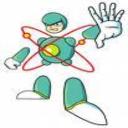PHYS 2001 Lecture 10: PHYS2001_Lecture_10

4.11 Equilibrium Conditions
Abjtii
ilib i
hit ltii
A
n o
bj
ec
t
i
s
i
n equ
ilib
r
i
um w
h
en
it
s acce
l
era
ti
on
i
s zero.
Thi th t
∑
0
a
m
F
v
v
∑
⇒
0
F
v
Thi
s means
th
a
t
:
∑
=
=
0
a
m
F
∑
=
⇒
0
F
In 2 dimensions then:
∑
=0
x
F
∑
=
0
F
∑
=
0
y
F
The forces acting on an object must balance in each direction!
Remember, zero acceleration does not necessarily mean no motion. As long
as the velocity does not change in time which means that a system moving at
as
the
velocity
does
not
change
in
time
,
which
means
that
a
system
moving
at
constant speed could be in equilibrium.
find more resources at oneclass.com
find more resources at oneclass.com

4.12 Non-equilibrium Conditions
If t i i
ilib i th it t b l ti
If
a sys
t
em
i
s
i
n non-equ
ilib
r
i
um,
th
en
it
mus
t
b
e acce
l
era
ti
ng.
∑
F
v
v
By Newton’s 2nd Law then:
∑
=
am
F
In 2 dimensions then:
∑
=
ma
F
In
2
dimensions
then:
∑
x
x
ma
F
∑
=yy maF
All the problems we will do can be classified as either an equilibrium or a
non-equilibrium problem.
If it’s an equilibrium problem, then the sum of the forces in both the x- and y-
direction will be zero.
If it’s a non-equilibrium problem, then the sum of the forces in the
x
-direction
will be maxand the sum of the forces in the y-direction will be may.
find more resources at oneclass.com
find more resources at oneclass.com

Example: The steel I-beam in the drawing has a weight of
8.0 kN and is being lifted upward at a constant velocity.
What is the tension in each cable attached to its ends.
Is this an equilibrium or non-equilibrium problem?
It is an equilibrium problem, since the beam is not
lti Thf
acce
l
era
ti
ng.
Th
ere
f
ore: ∑=0
x
F
∑
=0
y
F
Choose a coordinate system.
y
x
Draw the FBD.
Now break the vectors down into their components. Wis
along y, so it’s done, but Tneeds to be broken down.
T T
T
y
Ty
∑
=−= 0
xxx TTF
0
=
+
=
∑
W
T
T
F
W
T
=
⇒
2
TxTx
0
=
−
+
=
∑
W
T
T
F
yyy
W
T
y
=
⇒
2
From the figure: o
yTT 70sin=
70o70o
W
WT o=70sin2 o
W
T70sin2
=⇒ N 4260
70sin2
N 8000 == o
find more resources at oneclass.com
find more resources at oneclass.com
Document Summary
An object is in equilibrium when its acceleration is zero. ilib i bj t i i h it l ti i. The forces acting on an object must balance in each direction! Remember, zero acceleration does not necessarily mean no motion. As long as the velocity does not change in time which means that a system moving at as the velocity does not change in time, which means that a system moving at constant speed could be in equilibrium. If a system is in non-equilibrium, then it must be accelerating. ilib i t b th i i t it l ti v. By newton"s 2nd law then: = amf v. In 2 dimensions then: x ma y ma. All the problems we will do can be classified as either an equilibrium or a non-equilibrium problem. If it"s an equilibrium problem, then the sum of the forces in both the x- and y- direction will be zero.










